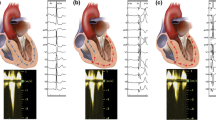Abstract
This review focuses on recent developments in the field of pacing in hypertrophic cardiomyopathy (HCM). Regarding mechanisms of action, recent data indicates that pacing acts by inducing dysynchronous left ventricular activation, thus reducing contractility and increasing end-systolic volume. Following several positive uncontrolled studies, three randomized crossover trials, with a total of approximately 140 patients, have now confirmed that gradients are on average halved with pacing but the reduction in symptoms has been modest and maximum exercise capacity has not been improved. These studies have identified a placebo effect from pacemaker implantation in HCM and have questioned the efficacy of pacing as a symptomatic therapy for HCM. There is probably a subgroup of patients with HCM who respond to permanent dual-chamber pacing but their precise identification is not yet clear. Permanent pacing should continue to be considered as one option in the management of the patient with drug refractory, symptomatic obstructive HCM.
Similar content being viewed by others
References and Recommended Reading
Pak PH, Maughan L, Baughman KL, et al.: Mechanism of acute mechanical benefit from VDD pacing in hypertrophied heart: similarity of responses in hypertrophic cardiomyopathy and hypertensive heart disease. Circulation 1998, 98:242–248. Elegant hemodynamic study of the effect of right ventricular pacing on left ventricular contractility and performance in the hypertrophied heart.
Sherrid MV, Pearle G, Gunsburg DZ: Mechanism of benefit of negative inotropes in obstructive hypertrophic cardiomyopathy. Circulation 1998, 97:41–47.
Pavin D, de Place C, Le Breton H, et al.: Effects of permanent dual-chamber pacing on mitral regurgitation in hypertrophic obstructive cardiomyopathy. Eur Heart J 1999, 20:203–210.
Maron BJ, Nishimura RA, Danielson GK: Pitfalls in clinical recognition and a novel operative approach for hypertrophic cardiomyopathy with severe outflow obstruction due to anomalous papillary muscle. Circulation 1998, 98:2505–2508.
Nishimura RA, Hayes DL, Ilstrup DM, et al.: Effect of dualchamber pacing on systolic and diastolic function in patients with hypertrophic cardiomyopathy. Acute Doppler echocardiographic and catheterization hemodynamic study. J Am Coll Cardiol 1996, 27:421–430.
Fananapazir L, Epstein ND, Curiel RV, et al.: Long-term results of dual-chamber (DDD) pacing in obstructive hypertrophic cardiomyopathy. Evidence for progressive symptomatic and hemodynamic improvement and reduction of left ventricular hypertrophy. Circulation 1994, 90:2731–2742.
Maron BJ, Nishimura RA, McKenna WJ et al.: Assessment of permanent dual-chamber pacing as a treatment for drugrefractory symptomatic patients with obstructive hypertrophic cardiomyopathy: a randomized, double-blind crossover study (M-PATHY). Circulation 1999, 99:2927–2933. Third and most recent of the randomized crossover trials of pacing in HCM. In a 48-patient, multicenter study the gradient was halved but symptoms and exercise capacity were not improved.
Gadler F, Linde C, Ryden L: Rapid return of left ventricular outflow tract obstruction and symptoms following cessation of long-term atrioventricular synchronous pacing for obstructive hypertrophic cardiomyopathy. Am J Cardiol 1999, 83:553–557. Randomized cessation of pacing in 10 patients that demonstrated a rapid return of obstruction and symptoms when pacing was stopped.
American College of Cardiology/American Heart Association guidelines for implantation of cardiac pacemakers and arrhythmia devices. A report of the American College of Cardiology/ American Heart Association Task Force on Practice Guidelines (Committee on Pacemaker Implantation). J Am Coll Cardiol 1998, 31:1175–1209.
Park MH, Gilligan DM, Bernardo NL, Topaz O: Symptomatic hypertrophic obstructive cardiomyopathy: the role of dual-chamber pacing. Angiology 1999, 50:87–94.
Nishimura RA, Tajik AJ, Allison TG, et al.: Dual-chamber pacing for hypertrophic obstructive cardiomyopathy: a randomized, double-blind crossover trial. J Am Coll Cardiol 1997 29:435–441.
Kappenberger L, Ryden L, Jeanrenaud X, et al.: Pacing in hypertrophic obstructive cardiomyopathy. A randomized crossover study. PIC Study Group Eur Heart J 1997, 18:1249–1256.
Linde C, Gadler F, Kappenberger L, Ryden L, for the PIC Study Group: Placebo effect of pacemaker implantation in obstructive hypertrophic cardiomyopathy. Am J Cardiol 1999, 83:903–907. Implantation of a pacemaker alone without active pacing had a placebo effect in the PIC study. Symptoms and, surprisingly, LVOT gradient decreased during the inactive pacing period although changes were greater with active pacing.
Gilligan DM, Maron BJ: Permanent pacing in hypertrophic cardiomyopathy. Cardiac Electrophysiol Rev 1999, 2:384–388.
Losi MA, Chiariello M, Stabile G, et al.: Dual chamber pacing in hypertrophic cardiomyopathy: influence of atrioventricular delay on left ventricular outflow tract obstruction. Cardiology 1998, 89:8–13.
Jeanrenaud X, Kappenberger L, Aebischer N, et al.: Dual chamber pacing in hypertrophic obstructive cardiomyopathy: beneficial effect of atrioventricular junction ablation for optimal left ventricular capture and filling. Pacing Clin Electrophysiol 1997, 20:293–300.
Gadler F, Darpo B, Linde C: Modification of atrioventricular conduction as adjunct therapy for pacemaker-treated patients with hypertrophic obstructive cardiomyopathy. Eur Heart J 1998 19:132–138.
Daubert C, Gras D, Pavin D, et al.: Biatrial synchronous pacing to optimize hemodynamic benefit of DDD pacing in hypertrophic obstructive cardiomyopathy [abstract]. Circulation 1995, 92(Suppl I):I-780.
McDonald K, McWilliams E, O'Keefe B, Maurer B: Functional assessment of patients treated with permanent dual chamber pacing as a primary treatment for hypertrophic cardiomyopathy. Eur Heart J 1988, 9:893–898.
Fananapazir L, Cannon RO, Tripodi D, Panza A: Impact of dual-chamber permanent pacing in patients with hypertrophic cardiomyopathy with symptoms refractory to verapamil and beta-adrenergic blocker therapy. Circulation 1992, 85:2149–2161.
Jeanrenaud X, Goy J, Kappenberger L: Effects of dual-chamber pacing in hypertropic obstructive cardiomyopathy. Lancet 1992, 339:1318–1323.
Slade AK, Sadoul N, Shapiro L et al.: DDD pacing in hypertrophic cardiomyopathy: a multicentre clinical experience. Heart 1996, 75:44–49.
Gadler F, Ryden L, Ribeiro A, et al.: Long-term effects of dual chamber pacing in patients with hypertrophic cardiomyopathy without outflow tract obstruction at rest. Eur Heart J 1997, 4:636–642.
Author information
Authors and Affiliations
Rights and permissions
About this article
Cite this article
Gilligan, D.M. Dual-chamber pacing in hypertrophic cardiomyopathy. Curr Cardiol Rep 2, 154–159 (2000). https://doi.org/10.1007/s11886-000-0013-6
Issue Date:
DOI: https://doi.org/10.1007/s11886-000-0013-6




